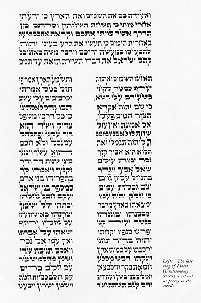
UNDERSTANDING RELIGIOUS EXPERIENCE AND EXPRESSION RELIGION 111 - Dr. Rennie THE CONTENTS OF THE JEWISH SCRIPTURES

The italicized words are Christian titles, usually from the Latin. Names in bold are Hebrew titles which are usually taken from the first significant word of each book. The Latin title usually relates to the contents.
The Hebrew Bible is called the Tanakh after the first letter of the name of the three sections of which it is composed.
I. TORAH ("teaching" or "instruction") = The Pentateuch or "Five Books" (of Moses). Probably dates from 1020 - 520 BC, it was completed around 400 BCE. Contains--
Bere'shit ("in the beginning") = Genesis
The genealogy (family tree) of mankind from Adam via Noah and his descendants after the Flood; God's covenant with Abraham to bring the people out of Egypt and give them the land of Canaan.
Shemot ("names") = Exodus
The period of bondage in Egypt and the Exodus ("coming out"); the giving of the Torah ("instruction") including the Decalogue or Ten Commandments given to Moses.
Va-yiqra' ("and he called") = Leviticus
Called "the Torah of the Priests" (Levite = Priest) this book includes the laws of worship, sacrifice, ritual purity ("kosher") sexual relations, and of festivals and times sacred to the Jews.
Be-midbar ("in the wilderness") = Numbers
The history of the wanderings in the desert after the flight from Egypt; some legal and ritual regulations.
Devarim ("words") = Deuteronomy
Contains speeches attributed to Moses shortly before his death which summarize the history of Israel and give ethical teachings. The emphasis is on the concentration of worship in one place, the Temple in Jerusalem.
II. NEVI'IM ("The Prophets") = The Prophets, completed around 200 BC
This section of the Hebrew canon (= a closed collection of scriptures)
is divided into two parts:
| (The Former Prophets) | (Latter Prophets) |
| Joshua | Isaiah |
| Judges | Jeremiah |
| Samuel | Ezekiel |
| Kings | 12 "minor" prophets |
The former relate Joshua's leadership after Moses' death and the ensuing period up to the Exile of the Judaeans in Babylon. The latter contain work of attributed to the literary prophets who lived in the 8th - 5th centuries BC.
III. KETUVIM ("writings") = Hagiography completed around 160 BC
Contains the literary works
Psalms
Lamentations
Song of Songs
Proverbs
Job
Ecclesiastes
and the historical works
Ruth
Esther
Daniel
Ezra
Nehemiah known as 1 and 2 Esdras in Catholic Bibles
Chronicles
These writings are regarded as having divine authority by all Christian denominations as well as all Jews and appear in all arrangements of the Christian Bible.
Although both Jews and Christians agree as to the authority of the preceding writings there are others which are disputed.
In the Jewish religion following the Tanakh comes the Talmud which is composed of Mishnah--a body of legal and theological material supposedly delivered by God to Moses at the same time as the Torah. It was not, however, written down until the period 200 BC - 200 AD. And Gemara, which elaborates on the Mishnah. Both these canons of literature were closed about the 5th century AD. They are not interpreted as authoritative in the Christian religion and do not appear in any Christian Bibles.
The three sections of the Hebrew Bible--Torah, Nevi'im, and Ketuvim--seem to represent three successive stages of collection and redaction (the work of editing). Although they contain material from as early as 1,200 BCE (approximately the same date as the g Veda) this material has been reworked and new material added.
After the immediately post-Exilic period no essentially new material was added to the Torah, although editing and organizing the old material continued. In all probability the Torah was finalized and closed some time between the Exile and the rebuilding of the Temple. (587-520 BCE) The Nevi'im were completed before the Seleucid conquest of Palestine (c.200 BCE), and the Ketuvim between then and the Maccabean revolt in 164 BCE.
It is notable that a Greek translation of the Hebrew Bible, called the Septuagint, was made sometime between 300 and 130 BCE in Alexandria in Egypt. This indicates an active Jewish community there who were gradually losing contact with the old language of Hebrew. So the Diaspora, the spread of the Jewish faith outside of Palestine was already well underway before the final destruction of the Temple by the Romans.
In the Christian religion there is a group of pre-Christian writings which were included in the Septuagint but which are excluded from the Hebrew canon. They are recognized by the Eastern Orthodox and Catholic Churches as "deuterocanonical," that is, as later additions to the canon. These are
Tobit (or Tobias)
Judith
The Wisdom of Solomon
Ecclesiasticus
Baruch (accepted only by the Catholic church)
1 & 2 Maccabees
The Prayer of Manasseh and
Supplements to the books of Esther and Daniel (The majority of Esther and Daniel are accepted by all)
The authority of these books is not accepted by the Protestant Churches who relegate them to a collection called the Apocrypha found in some Protestant Bibles.